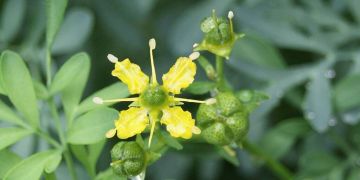A Brief History
Rue was well-respected by Hippocrates for its medicinal qualities. Aristotle touted it as essential for calming nervousness. Pliny recorded that it was used by artists to encourage eye health. When tied in bunches, this plant, also known as "herb of grace," was used in churches and cathedrals to sprinkle holy water. Rue was one of the active ingredients of Four Thieves' Vinegar, which was said to protect the opportunists who stole from those suffering from the effects of the Black Death. It was sprinkled on the floors of courthouses and carried by judges to ward of the illness and fleas that so often afflicted the incarcerated poor. The colloquial saying, "rue the day" is said to come from the discomfort caused by handling the leaves of Ruta graveolens. Its leaves are said to be the basis for the suit of clubs used on playing cards for centuries. This varied history only scratches the surface of this interesting and useful herb.
Native Invasive Plant
Ruta graveolens is thought to have come to southern Europe via northern Africa and the Mediterranean region. This hardy evergreen shrub then established itself throughout the continent and, with the help of British and Spanish colonialism, became a favorite in cottage gardens in the West Indies, India, Mexico and the United States. It is now a naturalized member of the flora of both North and South America and thrives easily in USDA growing zones 6 through 11. Standing up to two feet tall, Rue's little yellow flowers and green-gray stems and leaves can be found in culinary and medicinal herb gardens, butterfly habitats and growing of its own accord along roadways.
Rue Health Benefits
Historically, Rue has been used to relieve the pain associated with the physical symptoms of complaints such as gout, rheumatism, and sciatica. Along with alleviating the uncomfortable effects of gas and colic, rue was thought to expel worms from the body. Throughout the years of its use, rue has been used to promote menstruation. It is also used as a digestive tonic and to stimulate the appetite. The herb is edible and often used in salads. It is a good source of flavonoids.
Preparations
Ruta graveolens can be used fresh or dried. A beneficial tea or infusion can be sipped to calm the nerves, increase the appetite or to ease croupy symptoms. An oil made with Rue can be applied to areas suffering from sciatica or to ease chest congestion. Homeopathic preparations are available to treat arthritis and joint pain.





